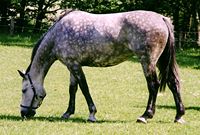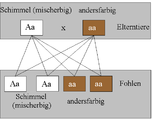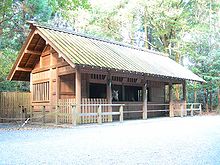White horse)

A gray horse is a white horse of any breed. Horses whose fur is lightened by numerous white burin hairs are also called mold.
In the narrower sense, a gray horse is a horse that is born with any color of coat and, due to the gray gene, becomes white over the years ( moldy out ). Anyone who carries the gray gene is a mold and can inherit the gene.
Real mold with a gray gene
Going out
A real mold carries the gray gene and is born with the basic color determined by the other color genes . So initially it is usually not white, but a fox , bay , black or it can have any other color and color variant. Over the years the horse gets more and more white hair and it becomes moldy. The color of the skin, iris, eyes and hooves is retained in adulthood, but Vitiligo - the white spot disease - occurs more often in very old molds. When the animal grows moldy, it gradually loses the color pigments in its fur and long hair: First the hair on the face and flanks becomes white, so that mold foals can often be recognized by a gray wreath around their eyes and nostrils. The original dark fur has already given way to the lighter fur of a gray horse in these places. The mold can take different lengths of time, but at some point all mold will turn white .
Designations for color and drawing variants of the mold
During the period of mold growth, molds differ in their color. At this time one speaks of brown mold, red mold, black mold , fox mold and gray mold ; a blue mold has evenly dark and white hair, an apple mold the darker hairs arranged in (half) circles.
When it comes to the "finished" mold, a distinction is made between the following colors: the Atlas mold is completely white, the fly mold has small red, brown or black spots in its fur, and the rose mold has small red spots in its fur.
Races
The mold color is quite common and occurs in most horse breeds. There are some breeds that are mostly or exclusively mold. The Camargue horse only has mold. Lipizzaners , Andalusians , Shagya Arabs and Boulonnais are mostly mold. Kladruber are either black or gray.
genetics
The gray gene (also known as the gray gene) is located on chromosome 25. A study showed that all molds have the same gene mutation. It is a mutation of the STX17 gene ( Syntaxin -17 gene), which causes this gene to be overexpressed . It is believed that the mutation stimulates the growth of melanocytes, with the result that some melanocyte stem cells, which are responsible for the coloring of the fur hair, die prematurely, while melanocytes in the skin spread excessively at the same time.
The gray gene (G) is dominant over the wild type (g). Horses that have inherited the mold gene from both parents (GG) look exactly like horses that have only one allele of the gene (Gg). In order to maintain the normal color, the gene combination must be present.
The dominant recessive inheritance of the gray gene follows Mendel's rules :
Health effects
The gray gene influences the expression of two genes: the silver gene and TYRP1, the mutations of which cause oculocutaneous albinism type 3 ( OCA3 ). As a result, mold in old age are particularly susceptible to melanomas , which are benign and in which the tumor markers are similarly pronounced as in the benign blue nevi (Naevi caerulei) in humans. The melanosomes (pigment granules) lack the usual internal structure and they often fuse with other melanosomes of the same melanocyte (pigment-producing cell).
In contrast, melanomas in horses that are not mold are often malignant. These malignant melanomas can also occur in white horses, but are no more common there than in colored horses.
Mold in the broader sense
In a broader sense, the word mold is often used to refer to all horses with a completely white coat and all horses whose coat color has been lightened by a significant amount of white burin hair. However, modern horse breeding uses the term mold in a narrower sense.
If a white horse shows pink skin on its body (the "real" gray horse always has black skin), then it is one of the other colors.
In addition to molds, the following horse colors can lead to a completely white coat:
| designation | Differentiation from real mold |
|---|---|
| Cremello, Perlino, Smoky Cream : | Horses differ from gray by their pink skin and blue eyes. The fur has a light golden or silver sheen. Some palomino foals that have only one cream gene are also almost completely white. |
| Dominant white horse : | light brown eyes and pink skin, absolutely white fur |
| Maximum piebald : | different eye color, snow-white fur, pink skin |
| Burin-haired horse or permanent gray horse : | Differs in its dark face, but confusingly, it is sometimes referred to as blue, red, or brown. The amount of white hair changes with the seasons, but the horse does not get lighter with life. |
| Rabicanos | especially in the chest area and on top of the tail, legs, hips, shoulders, head and neck remain dark. |
| Varnish roan : | A dark V-mark remains on the face as the horse becomes lighter in the course of its life, dark fur extends to the knees and hocks, and dark spots at the base of the legs. |
| Sabino : | There is always at least one blaze, usually a lantern, on the face. Usually there are also badges on the legs. The mane and tail turn white when prickly hairs appear. |
| Horse-colored horses | do not have black and white hair mixed in, but rather evenly gray fur in the dark areas (resembles the apple mold) |
| Volltiger : | The dark spots are not the size of a fly, but the size of a walnut to an apple (similar to the fly mold) |
Mold in folklore, religion and literature
- Venetian (Adriatic Sea) : Only mold were sacrificed in the Venetian sanctuaries.
- Arabia : The white horse was a symbol of success and luck for the Arabs, white horses were often sacrificed or were part of solemn ceremonies
- Poland: "Have you never sat on a white horse, you have never ridden a good horse." - Old Polish proverb
- Celtic mythology: In Irish Celtic mythology, a white horse is the symbol of death.
-
Japan:Mold in the Ise Shrine in Japan
- In Japan, women are assigned a special relationship with horses, especially white horses. To prevent such enchantment, a woman is not allowed to show the breast to a horse or has to evade when encountering a white horse. But once a horse has enchanted a woman, it will hold fast to her and will not let go of the enchanted woman, even if it is killed. In several Japanese legends, horses fall in love with a woman - with different but mostly unfortunate endings - for example, the origin of the silkworm is ascribed to such a relationship.
- The aouma no sixie ("Festival of the White Horses") was probably originally a fertility ritual . This is how molds are considered to be lucky charms. It is said that anyone who encounters a gray horse on the 7th day of the New Year's month will stay away from all misfortune in the coming year. The white horse was probably originally taboo as a holy animal of heaven for everyday use.
- This idea has also been connected with the belief in horses as gods or masters over a pond or lake, whereby these horses are very often white.
- In Theodor Storm's novella Der Schimmelreiter , a gray horse bought as a Klepper embodies the uncanny, ghostly character of the main character Hauke Haien .
See also
Web links
- Winning Colors is NOT a roan! (Differences between gray horses and stick-haired horses (roan))
swell
- ↑ a b The white mold.
- ↑ a b Tactical: Schimmel.
- ↑ Science Daily, July 23, 2008
- ↑ MM Locke, MC Penedo, SJ Bricker, LV Millon, JD Murray: Linkage of the gray coat color locus to microsatellites on horse chromosome 25. In: Anim. Genet. 33 (5), 2002 Oct, pp. 329-337. PMID 12354140 .
- ^ JE Swinburne, A. Hopkins, MM Binns: Assignment of the horse gray coat color gene to ECA25 using whole genome scanning. In: Anim. Genet. 33 (5), 2002 Oct, pp. 338-342. PMID 12354141 .
- ↑ G. Pielberg, p Mikko, K. Sandberg, L. Andersson: Comparative linkage mapping of the Gray coat color genes in horses. In: Anim. Genet. 36 (5), 2005 Oct, pp. 390-395. PMID 16167981
- ^ Coat color, gray (Phene ID 2696, Group 001356) in Equus caballus OMIA - online Mendelian Inheritance in Animals.
- ↑ Gerli Rosengren Pielberg et al: A cis-acting regulatory mutation causes premature hair graying and susceptibility to melanoma in the horse. In: Nature Genetics . 40, 2008, pp. 1004-1009. doi: 10.1038 / ng.185 ; science.orf.at: Gene mutation turns the Lipizzaner horses into molds ( page can no longer be accessed , search in web archives ) Info: The link was automatically marked as defective. Please check the link according to the instructions and then remove this notice. , accessed July 21, 2008.
- ↑ a b c Krista Siebel: Analysis of genetic variants of loci for the coat color and their relationships to the color phenotype and to quantitative performance characteristics in pigs. Inaugural dissertation to obtain the degree of Doctor of Veterinary Medicine, Institute for Livestock Sciences at the Humboldt University in Berlin. July 2001.
- ↑ a b c S. Rieder, C. Stricker, H. Joerg, R. Dummer, G. Stranzinger: A comparative genetic approach for the investigation of aging gray horse melanoma. In: Journal of Animal Breeding and Genetics. Volume 117, Number 2, April 2000, pp. 73-82.
- ↑ Monika Heidemarie Seltenhammer, Elisabeth Heere-Ress, Sabine Brandt, Thomas Druml, Burkhard Jansen, Hubert Pehamberger, Gert Willhelm Niebauer: Comparative Histopathology of Gray-Horse-Melanoma and Human Malignant Melanoma. In: Pigment Cell & Melanoma Research . 17 (6), pp. 674-681. doi: 10.1111 / j.1600-0749.2004.00192.x
- ↑ K. Ohmuro, K. Okada, A. Satoh, K. Murakami, S. Satake, M. Asahina, S. Numakunai, K. Ohshima: Morphogenesis of compound melanosomes in melanoma cells of a gray horse. In: J. Vet. Med. Sci. 55 (4), 1993 Aug, pp. 677-680.
- ^ W. Gebhart, GW Niebauer: Comparative investigations of depigmented and melanomatous lesions in gray horses of the lipizzaner breed (author's transl.). In: Arch. Dermatol. Res. 259 (1), 1977 Jul 21, pp. 29-42. German. PMID 900991
- ↑ JC Patterson-Kane, LC Sanchez, EW Uhl, LM Edens: Disseminated metastatic intramedullary melanoma in an aged gray horse. In: J. Comp. Pathol. 125 (2-3), 2001 Aug-Oct, pp. 204-207.
- ^ Sydney D. Markman: Horse in Greek Art. Biblo & Tannen Booksellers & Publishers, 1969, ISBN 0-8196-0247-7 .
- ↑ a b c Nelly Naumann : The horse in legend and customs of Japan. (PDF) In: Folklore Studies. Vol. 18, 1959, pp. 145-287.









